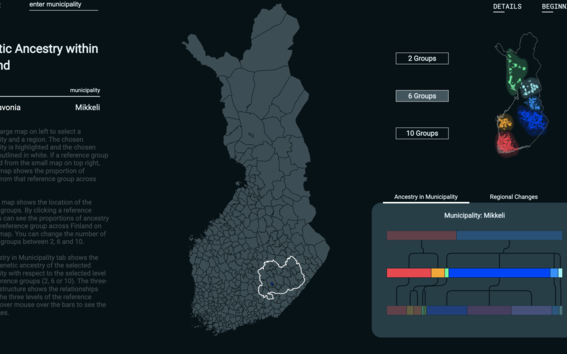New data visualization provides creative ways of analyzing the genetic ancestry of Finland

Commercially available gene tests that shed light on individual’s origins are popular. They provide an estimate of the geographic regions where one’s ancestors come from. To arrive at such an estimate, the genetic information of an individual is compared to information pertaining to reference groups collected from around the world.
The findings now made by researchers from the University of Helsinki, Aalto University and the Finnish Institute for Health and Welfare make it possible, for the first time, to make similar comparisons within Finland.
The results of a new study made it possible to follow the traces of 20th century events in our genes and assess the effect of migration on the genetic mixing of the population. For example, it was possible to trace the migration of the evacuees from Finnish Karelia all across Finland on an annual level by exploring the share of the Karelian ancestry among the newborns of a given region.
The results have been published in the PLoS Genetics journal. In addition, the researchers have launched a website for the project, where anyone can browse the results using an interactive map. Aalto University's School of Arts, Design and Architecture and the Department of Media was responsible for the information design and interactive data visualization which provided creative ways of visual analysis of the genetic ancestry of Finland.
“Our aim was to create an interactive visualization not only for scientific visual analysis but also for making the subject understandable and accessible for the general public in Finland”, says professor Rupesh Vyas, leader of the Aalto project team. The team members were researchers Cerioli Nicola and Pacauskas Darius.
Professor Rupesh VyasThe visualization was created not only for scientific analysis but also for making the subject understandable for the general public.
A research group at the University of Helsinki, headed by Associate Professor Matti Pirinen, who directed the study, has already earlier produced very detailed information on genetic structure in Finland. In the recently published study, reference groups were compiled from Finns with similar genetic ancestry and then applied to track the effects of migration in the 20th century on the population level.
The work is based on samples collected in the FINRISK study by the Finnish Institute for Health and Welfare. Using the reference datasets compiled from the samples, Finns can be classified on three different levels according to their geographical origin with fairly high precision. The first level separates Finns on the east–west axis, while the 10 different reference groups on the most detailed level partially match the former provinces of Finland.
The model used in the comparison works best when most of the individual’s ancestors are from the same geographic region. The greater the dispersion of the ancestors, the less accurate the estimate provided by the model is.
“Determining genetic ancestry on nearly the provincial level in Finland would be exciting for anyone interested in recent history,” says Sini Kerminen, who recently published a doctoral thesis on the topic at the University of Helsinki’s Institute for Molecular Medicine Finland (FIMM).
Furthermore, the study observed the effect of recent genetic mixing in different areas in Finland on the basis of people’s year and place of birth. A study of this temporal and geographical precision has never before been conducted anywhere in the world.
According to the findings, the genetic impact of the evacuation of the Karelian region ceded to the Soviet Union has been greater than that of the post-war urbanisation. Moreover, clear differences were seen within Finland with regard to how much population mixing had taken place in the period covered by the study, from the 1920s to the 1980s.
The most notable change was seen in the Uusimaa, Varsinais-Suomi and Häme regions, where the share of southwestern ancestry had declined by more than 20 percentage points. Changes of such magnitude and speed illustrate migration within the country and indicate that more people have migrated in the 20th century from east to west than in the opposite direction in Finland. The least change was observed in the Ostrobothnia region.
“By monitoring the share of the Karelian ancestry in the newborn population of the regions studied we can trace the movement of evacuees at almost an annual level. For example, Karelian ancestry in Ostrobothnia appears to have increased substantially in wartime. However, already in the 1950s it had largely disappeared from the region, unlike in the Uusimaa region and southwest Finland where the share of Karelian ancestry seems to have stabilised at the wartime level,” says Associate Professor Pirinen.
According to the research group, detailed understanding of the fine-scale genetic structure of the population is also important for medical projects that utilise genomic information.
“Finally, we want to emphasise that genetic background is not the same as national or cultural identity, which means that our results cannot be used to determine who is a Finn,” Pirinen states.
The study received funding from the Sigrid Jusélius Foundation and the Academy of Finland. The work on the interactive visualization was funded by the Department of Media, Aalto University School of Arts, Design and Architecture.
For more information:
Professor Rupesh Vyas
[email protected]
+358 50 598 8032
- Published:
- Updated:
Read more news

DeployAI Partners Gather for Heart Beat Meeting in Helsinki
The European DeployAI project's partners gathered for the Heart Beat meeting hosted by Aalto University Executive Education in Helsinki.
Get to know us: Associate Professor Maria Sammalkorpi
Sammalkorpi received her doctorate from Helsinki University of Technology 2004. After her defence, she has worked as a researcher at the Universities of Princeton, Yale and Aalto.
Aalto computer scientists in ICML 2024
Computer scientists in ICML 2024